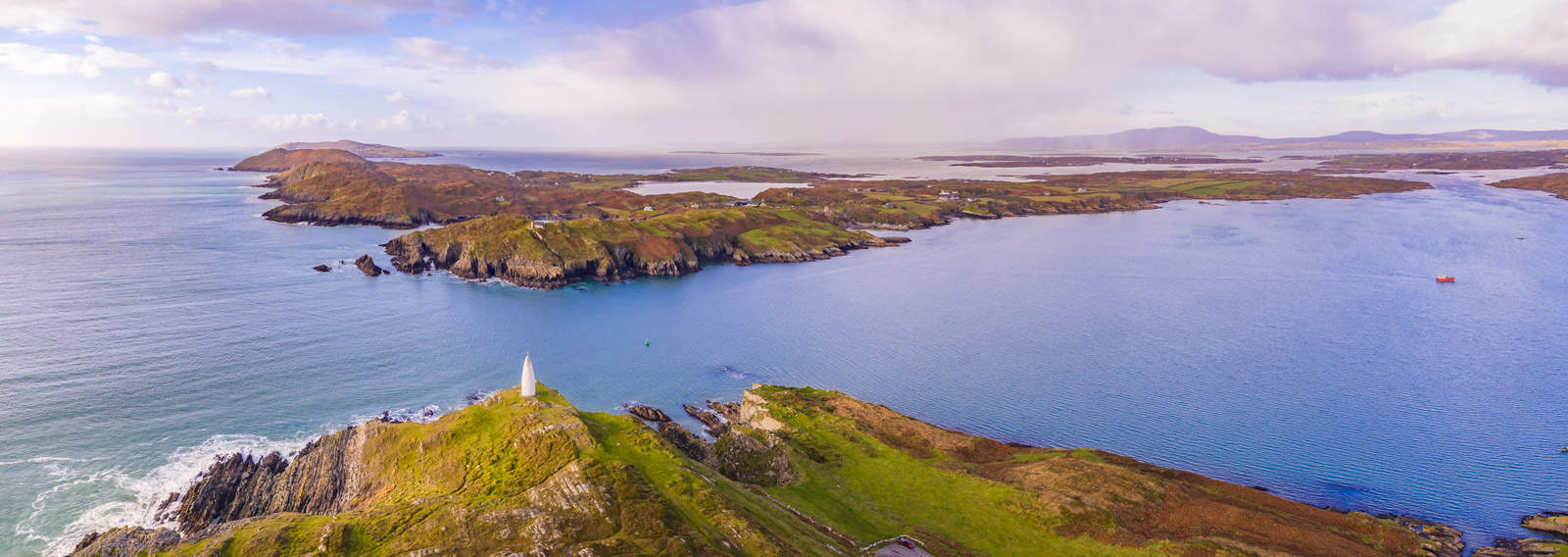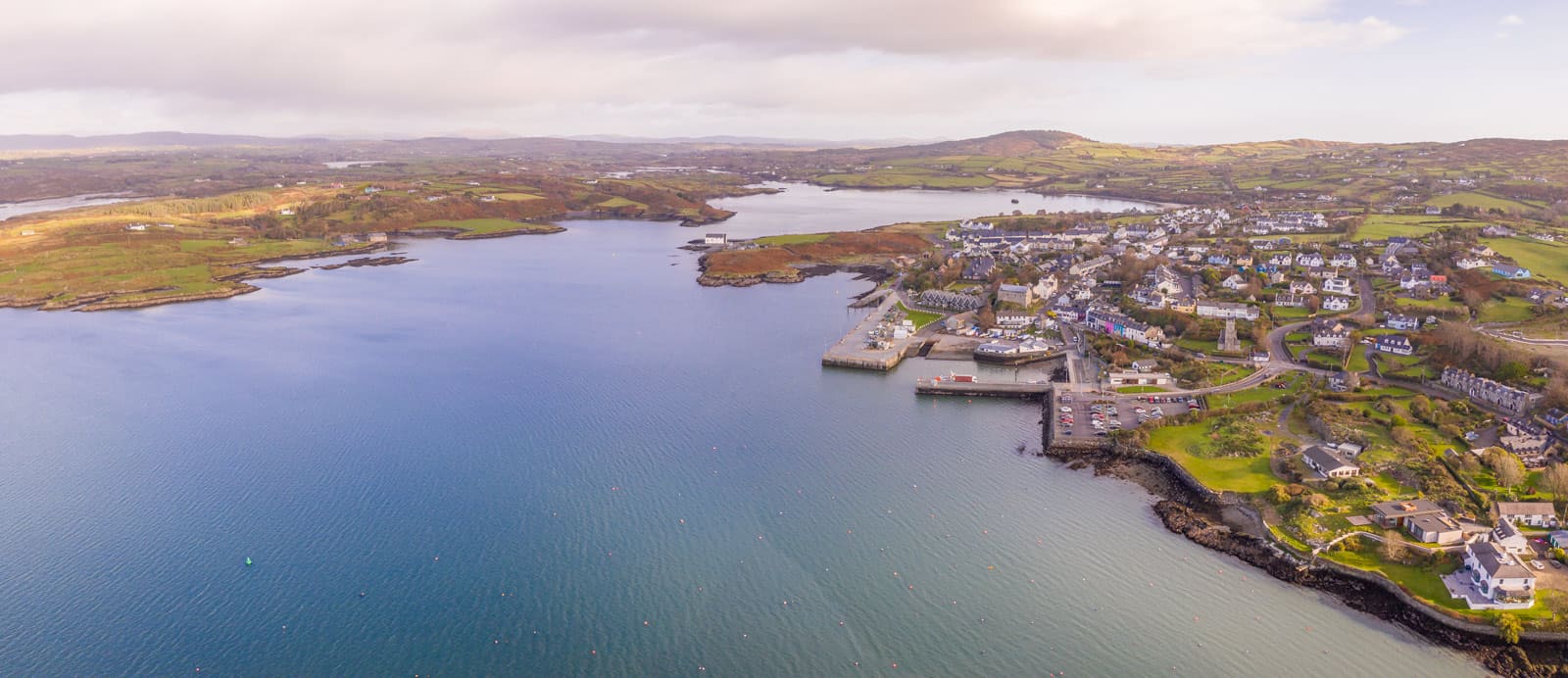The Sack of Baltimore – the Pirate’s Came at Night

The Sack of Baltimore.
With the iconic white beacon taking watch on the clifftop above the town as well as the hustle and bustle of the harbour, from which many ferries and boat tours depart – Baltimore in West Cork is undoubtedly one of the most popular destinations for a Sunday spin or a few nights away during the summer months.
Following the road through the village and leaving the chatter around the outdoor tables of the pubs along the harbour promenade behind the cove awaits at the bottom of the Beacon Road with its tranquil atmosphere and clear blue water. It is hard to imagine that almost 400 years ago this very spot was set to the largest pirate attack on an Irish coast, which is commonly known as the Sack of Baltimore!
Read on to find out how the attack unfolded, what happened to the 107 victims and how the effects of this one night shaped West Cork, as we know it today!
Baltimore Before the Sack
Baltimore’s entanglement with piracy started long before the infamous attack though. The village, as well as the islands Sherkin and Cape Clear, were owned by the notorious seafarer clan O’Driscoll who were known for their involvement in smuggling, raiding and similar activities which are typically associated with pirates. They had been plundering other Irish cities like Waterford and even tricked entire crews of ships anchoring in Baltimore harbour in a way that allowed them to take possession of ships and cargo alike.
The last chieftain of the clan, Sir Fineen O’Driscoll allegedly let his territory to the English lawyer Sir Thomas Crooke in 1605 on a 21-year contract. Even though this agreement was the reason for many disputes and quarrels it was the beginning of Baltimore as successful fishing and trading port. Only a few years later the town was mainly inhabited by English fishermen as well as tradesmen. Business was going great for the people of Baltimore, the port quickly became a well-known transshipment point for wine and other goods.
June 1631 – Corsairs on the Way to West Cork
While the 17th of June 1631 was just a regular day in Baltimore, it was the day that proofed to be a fateful one for many, as it was the day two ships set sail in Algier. The two vessels were lead by the infamous Dutch-born corsair Jan Janszoon, who after converting to Islam was better known under the name Murat Reis the Younger. Reis and his crew were on the way to Europe to carry out a slave raid. Their only objective was to capture Europeans, abduct them to the Middle East and sell them into slavery. The business of selling white slaves was quite lucrative at the time.
While the original plan was to raid the village of Kinsale, two fishing boats and their crews which were captured by the pirates off the coast of the Old Head of Kinsale on 19th of June 1631 changed these plans considerably. The captive John Hackett, a native of Dungarvan, was pressured to lead the fleet into Kinsale harbour. However, Hackett was aware of a royal navy ship being anchored in Kinsale bay and fearing for his life he traded this information together with a recommendation to raid Baltimore instead in order to stay alive.
With Hackett’s directions, Reis and his crew continued on along the Irish coast to Baltimore. Records show that the ships were spotted from Castlehaven on the afternoon of the 19th of June 1631. Since they most likely sailed under the flag of a friendly nation, the presence of the vessels was merely noted but not seen as a cause for alarm.
While the Village was Sleeping
At around 10 pm the pirates anchored their ships to the east of Baltimore harbour. From there Reis, Hackett, and a small troop of men took to shore in small boats. After landing close to the small cove of Baltimore, Hackett guided the corsairs around the small village, giving them an overview of the layout and allegedly sharing information of inhabitants. Satisfied the pirate captain and his crew retreated to their ships, formulated a plan of attack and waited until the last of the villagers went to bed for the night.
At around 2 am on the morning of 20th of June 1631 about 230 men took to their boats and made their way silently to the beach of Baltimore’s cove. Armed with muskets and torches they positioned themselves outside of the 26 cottages along the cove waiting for a signal to use the element of surprise and simultaneously attack their unsuspecting victims.
Once the signal was given they broke through the doors, waking the sleeping inhabitants with terror while literally taking them from their beds and setting their houses and livelihoods on fire. During this first phase of the attack 100 men, women and children were captured while two men, who put up resistance were killed. After their living booty was secured and guarded by some of the pirates. Murat Reis the Younger and 60 of his men made their way up to the main village, where they were planning to carry out another surprise attack.
This second phase of the attack was initially a success for the corsairs as another 40 houses were raided, however one of the villagers managed to set off the alarm in form of drums. As Baltimore began to wake and set to the streets to fight for their town and people the pirates – now without their advantage of surprise – began to retreat to their ships, taking with them their plunder of 20 men, 33 women and 54 children!

The Sacked of Baltimore: Destined as Life in Slavery
It is reported that the pirates stayed anchored just outside of Baltimore for another few hours before eventually setting sail to begin their return journey to Africa. Before leaving Irish waters the pirates sent the previously captured fishermen, including John Hackett as well as two elderly prisoners from Baltimore back to shore. Hackett was later tried and sentenced to death for aiding and abetting an attack on his country.
During these early hours of captivity, Reis and his crew showed their power and authority in a bid to prevent their prisoners from trying to escape. Particularly the strong and young men were treated with brutality and in some cases nearly beaten to death. Due to their higher value on slave markets, women and children received much better and in some instances even kind treatment by their captors.
From this moment the fate of the people taken from Baltimore is mainly speculation and pieced together from some sparse reports as well as narratives from captives taken in similar raids at around the same time. It is known that the two ships carrying the men, women, and children from West Cork arrived back in Algiers, at this time all the captives were reported to be alive. According to local customs at the time, the Basha of Algier was entitled to ten percent of every booty entering the harbour. The captives of Baltimore were no different and were taken straight to the Basha after disembarking the pirate ships. Whoever was left ended up being chained up in a slave pen, where potential buyers could inspect them before an initial auction.
Men, women, and children were separated at this point and anyone who wasn’t sold during the first or second auction after arrival moved on to a so-called bagnio, a storage shed for slaves, from where they were rented out for casual work on a contract basis. While men were bought for their skills, white women were acquired for prestige and often ended up living comfortable and even luxurious lives compared to female slaves of other ethnicities. Children were often sold into families, where they were raised as Muslims and given a role in the community – others were brought up to be soldiers and became part of the Ottoman army!
What Became of the Slaves of Baltimore?
The exact fate of the 107 people taken from Baltimore in 1631 is mainly unknown. It is documented that after 15 years in captivation two women, who were abducted during that fateful night, were ransomed by the British official Edmund Cason. He paid 150 dollars for the release of Joan Broadbroke, who was recorded as being taken together with her two children while being heavily pregnant. Cason was also able to ransom Ellen Hawkin for a price of 86 dollars. Even though Ellen Hawkin’s name is not listed as being taken from Baltimore, it is believed that she was one of the five captives who were simply listed as maids. The two women returned to England where they were allegedly given jobs by the government. What has become of their former neighbours and friends from Baltimore is unknown.
Baltimore – a Changed Village
The 20th of June 1631 was quite possibly the most fateful day for Baltimore and the surrounding area. After the pirates had left with their plunder the surviving villagers were left with the ashes of their houses and lives. Most had not just lost all their belongings overnight but many would never see their spouses, children or parents again. In a bid for more safety, they turned their backs on the sea which would forever hold the possibility of another attack and made their way inland. Eventually, they joined a very small settlement at the River Ilen, after all the only life they knew revolved around water. On their quest to find a new safer home and a brighter future, the refugees of of Baltimore unknowingly formed a community which over the coming centuries would develop into the flourishing and well-known market town of Skibbereen! This fact alone begs for one of history’s most asked questions: What if? – What if, John Hackett would have managed to warn the villagers of Baltimore and the raid wouldn’t have been successful, what if, the pirates would have attacked Kinsale as originally planned or would have never come to the shores of West Cork? Would Baltimore, Skibbereen and the South of Ireland still exist in the way we know it today? Fact is, the Sack of Baltimore didn’t just change the fate and lives of those taken and those left behind but also had an impact on how we live our lives today. Over the years the event with all its brutality, mystery and unanswered questions fascinated many. The author Des Ekin gives a very detailed account of the attack in his book “The Stolen Village”. Another artist who managed to tell the tale of this fateful night in the most breathtaking way was the poet Thomas Osborne Davis whose poem “The Sack of Baltimore” encapsulates the entire array of emotions the villagers must have felt back in the early hours of the morning on 20th of June 1631!
Thank you for reading my blog post on the sack of Baltimore.
I have another blog post on Galley Head Lighthouse you may be interested in.
See you out there,
Kieran.
